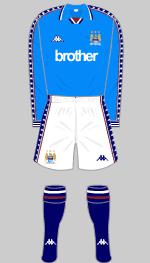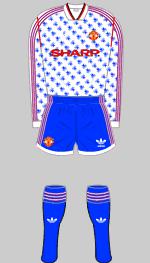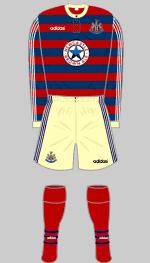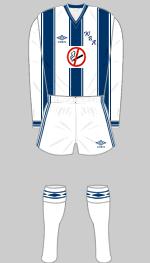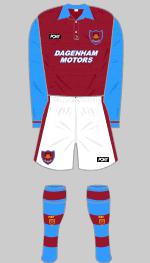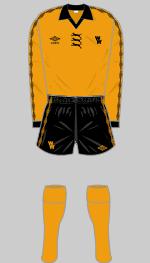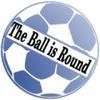So after last week’s first look at the history of shirts sponsorship in the Premier League, we are proud to deliver part two below. Many thanks again to Historic Kits for the use of their excellent graphics. It really is a top site.
Manchester City – Few people will remember the first name blazoned across the famous pale blue shirt of Manchester City. Everyone remembers Brother, the copier people, who took over in 1987 but prior to this it was Saab (1982 to 1984) before Philips took over. Brother were around for 12 years as the club slid down the leagues, reaching the third tier of English football when Kappa became the main kit supplier taking over from Umbro who had been the suppliers since 1975. Eidos and Le Coq provided cheap kit for a few years for JJB Sports up and down the country before the Reebok era arrived in 2003 and Thomas Cook became the main shirt sponsor. After a brief return to Le Coq in the late noughties it has been Umbro and Etihad ever since.
Manchester United – The biggest footballing brand in the world has only had four shirt sponsorship deals since they signed their first contract back with Sharp in 1982. Back then the club were mid-table also rans with a crumbling stadium and still living on the past glories of Bobby Charlton and George Best. Adidas were the shirt manufacturers and that relationship was in place until 1992 when Umbro took over cutting the cloth. In 2002 Vodafone signed a multi-million pound deal for an initial 3 year deal, later extended until 2006. In that period Nike also became the kit manufacturer, producing at least one sometimes two and on one occasion three new kits a season. The American insurance group (amazingly) with the name AIG signed in 2006 in a deal worth £56m prior to being plunged into the global financial crises. Man Utd needn’t have worried as in June 2009 AON agreed to pay £80m over 4 years.
Newcastle United – The Toon actually started life as West End FC back in 1881, playing in a red and black striped kit (as well as claret and blue for a season). When they started life as Newcastle they actually played in a red and white strip for two years before introducing the iconic black and white shirts. Uniquely Newcastle didn’t splash a name across their chests when shirt sponsorship was allowed in the early 1980′s. Instead they carried the iconic logo of Newcastle Brown Ale for six years until 1986 on the classic Umbro shirt. The beer theme was continued with Greenall’s Beer from ’86 to ’90 when the Brown Ale logo returned, being replaced in 1995 with the Brown Ale bottle label. With Adidas and Shearer in full force for the club they introduced their best ever away kit (right) during this period. NTL took over for 3 years around the Millennium before Northern Rock spent money they potentially didn’t have on the shirt sponsorship in 2003 and amazingly are still going strong today in a deal that could be worth up to £10m, although the kit is now manufactured by Puma.
Stoke City – Stoke fans look away now. Your team have actually played in almost every colour striped shirts going in their early days, ranging from an almost Crystal Palace red and blue, through a Hull yellow and black and even an Inter Milan black and blue before they settled on the red and white stripes in 1908. Umbro first put their name on the shirts in 1975 with Ricoh (as in Coventry City fame) became the first sponsors in 1981. Over the next fifteen years the club went through a variety of sponsors as was(is?) the like with lower league teams with Cristal Tiles, Fradley Homes, Ansells, Carling, Broxaps (they made litter bins fyi) and kit manufacturers Ascis before Britannia Building Society signed their initial deal in 1997 and 14 years later are still going strong as the team made their debut appearance at Wembley Stadium in the FA Cup semi final with a very snazzy Adidas number. As with opponents Bolton Wanderers, the value of long terms sponsorship across a number of assets (such as the stadium) is clear to see.
Sunderland – Umbro continued their domination of kit manufacturing in England when they started producing the kit for Sunderland in the mid-70s. Apart from a very strange variation on red and white striped shirts in 1981 to 1983 (right) the kit has gone through little changes. 1983 Cowie’s became the first sponsor, interestingly enough with one of the first ever Nike manufactured kits. Cowie’s gave way in 1985 to a long term partnership with local brewer Vaux, although the manufacturer changed frequently with Patrick, Hummel, Avec, Ascics, Nike (again), Diadora, Lonsdale before returning to Umbro in 2007. During this period Vaux were replaced by Reg Vardy, a local motor dealership before betting company Boyle Sports signed a £12m 4 year deal in 2007. They were replaced at the start of this season by Tombola, an online bingo company in a two year deal.
Tottenham Hotspur – Spurs are one of the clubs with five or less sponsors since shirt advertising was allowed back in 1983. Their initial deal was with Holsten, the German brewer and lasted through the Hoddle, Gazza and Lineker period until 1995. During this period there was the famous FA Cup final against Coventry City when only some of the players wore shirts with the logo on the front in a massive balls up. However, it probably brought Holsten more brand awareness! Hewlett Packard took over the deal in 2002 when the club also adopted a Pony kit, still a joke today for Arsenal fans. Holsten re-appeared on a brand new Adidas strip in 1999 for three years before Kappa brought some “snug” fitting shirts to the table, along with a sponsorship deal with Thomson which ran until 2006. Puma then took over along with Mansion Casinos in a £34m deal back in 2006 for three years. The most recent deal with Autonomy is worth between £20 and £50m..nice work if you can get it!
West Bromwich Albion – If you thought Stoke had trialled a few different coloured kits, then West Bromwich Albion have gone through a department store’s worth. Ten different coloured striped shirts in their formative years before they settled on the dark blue and white stripes in 1889. With Ron Atkinson in charge, and his “Three Degrees” in full force the club signed their first sponsorship deal with BSR in 1981. Swan (as in matches?) were the next sponsors until 1984 when the club went all “Public Service Announcements” with a No Smoking Logo slap bang in the middle of their shirts for two years. Umbro, who had been kit manufacturers since 1975 continued through until 1989 where Apollo 2000 (a local electrical chain) were sponsors. Various sponsors and strange manufacturers came and went in the 1990′s including Sandwell, Colcher, Guests and the West Bromwich Building Society for the former, whilst the latter included such names as Scoreline, Influence, Pelada and The Albion Collection. Oooh, get you! T-Mobile took over for four years in 2004 and then the club made the ultimate sacrifice and went without a sponsor for a season in 2008/09. Last season they took part in a special deal with the Football League where their shirts actually carried a total of 10 different names during the season based on TV requirements including SBOBet, Leons, Bathams, England 2018, BlueSquare and Help Chile. Good to see clubs value the space across their chest and not devaluing their brand! This season they are advertising Homeserve Insurance with their telephone number 247999…hmmm
West Ham United – Ah, my beloved Hammers. The famous claret and blue shirts have been worn by the Hammers since 1901. Bukta were the first manufacturers in time for the 1975 FA Cup final win over Fulham, only to be replaced by Admiral the following year, who were still the sponsors when they won the cup again over Arsenal in 1980. The following year when the club took the Second Divisions by storm they wore a new Adidas strip. The following year the club introduced a new kit with a horizontal blue band across the front, which was perfect for a sponsors name and that is what happened a few months into 1983/84 season when finance company Avco Trust signed a deal with the Hammers. Avco were a local company and they were replaced in 1989 with another local company, BAC Windows and Doors. Scoreline had replaced Adidas by this stage but only for a season or two before Bukta returned with some rather trendy (well for the early 90′s) designs. In 1993 the embarrassment deepened with Pony taking over the manufacturing duties and Dagenham Motors providing the name on the front. After a blank season in 1997/98 Dr Martens rolled into town to add their name to the Fila manufactured shirt as well as to the brand new West Stand. Jobserve picked up the shirt naming rights on relegation from the Premier League in 2005 as well as Reebok being the new maker. In 2007 Umbro started producing the kit and XL holidays became the sponsors. Unfortunately in September 2008 they went bankrupt. Instead of replacing the kit, West Ham went down the cheapskate model and simply stuck large shirt numbers over the XL logo! In December 2008 SBOBet, an online gaming company with no presence in the UK took over the deal with childrens replica shirts featuring the Bobby Moore Cancer Trust. This season Macron, a brand better known for providing kit to the Ryman League have taken over manufacturing of the kit. No comment.
Wigan Athletic – It is still amazing to think that just over thirty years ago Wigan Athletic were a small Northern Premier League team. Four years after entering the league when they were getting crowds of a few thousand at the antiquated Springfield Park, Wigan were running out in their Baldwin Group Umbro sponsored kit. In 1982 JSW (?) produced the kit with Bulldog Tools on the front. Kit manufacturers came and went over the next few years with names such as Hobott, New Balance, Erima, Elgreen and Matchwinner involved, whilst local superbrand Heinz provided stability in terms of sponsorship from 1984 until 1994 when Dave Whelan got involved in the club as they started their rise up the leagues and quite rightly put his JJB brand on the front of the shirts. Kit manufacturers continued to change on a regular basis including Adidas, Puma, Patrick, JJB (keeping it inhouse), Umbro, Champion, Vandanel and then this season Mi Fit (who???) providing the strip now sponsored by 188Bet.
Wolverhampton Wanderers – Ever heard of Tatung? What about Staw, Benjamin Perry or Manders? No, neither have we but they were some of the original sponsors of Wolves’s famous old gold shirts. Then along came Goodyear in 1990 to bring some stability to the Steve Bull era, although the manufacturer was a hot potato including the inhouse Molineux brand for a couple of years before Nutmeg took over in 1994. Puma took over for a couple of seasons and then BANG. The colour of the strip seemed to get darker, Admiral arrived as manufacturers and Doritos added their brand to the kit. Le Coq became manufacturers in 2004 with Chaucer taking over from the crisps and continued to make the kit until the end of last season. This year it is that well known brand Burrda with Sportingbet becoming main sponsor in a “seven figure deal” over two seasons.
So there we have it. A stroll through the kits and manufacturers of the twenty Premier League clubs…some classics in here as well as some bizarre deals. It is only natural our next venture into the archives will be for the worst ever kits – and there are more than enough candidates for the top ten!
